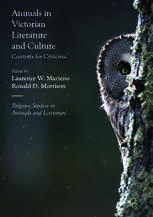
Animals in Victorian Literature and Culture: Contexts for Criticism PDF
Preview Animals in Victorian Literature and Culture: Contexts for Criticism
Palgrave Studies in Animals and Literature Series Editors Susan McHugh English Department University of New England Biddeford, Maine, USA Robert McKay School of English University of Sheffield, Sheffield United Kingdom John Miller School of English University of Sheffield, Sheffield United Kingdom Beforethe2000sthehumanitiesandsocialsciencespaidlittleattentiontothepartici- pationofnon-humananimalsinhumancultures.Theentrenchedideaofthehumanas a unique kind of being nourished a presumption that Homo sapiens should be the proper object of study for these fields, to the exclusion of lives beyond the human. Againstthisbackground,variousacademicdisciplinescannowbefoundintheprocess of executing an ‘animal turn’, questioning the ethical and philosophical grounds of humanexceptionalismbytakingseriouslytheanimalpresencesthathauntthemargins ofhistory,anthropology,philosophy,sociologyandliterarystudies.Instancesofsuch workaregroupedundertheumbrellaterm‘animalstudies’,havinglargelydevelopedin relation to a series of broad,cross-disciplinary questions. Howmight we rethink and problematisetheseparationofthehumanfromotheranimals?Whataretheethicaland political stakes of our relationships with other species? How might we locate and understand the agency of animals in human cultures? While debates around these themes continue to develop across academic disciplines, this series will publish work that looks, more specifically, at the implications of the ‘animal turn’ for the field of EnglishStudies.Languageisoftenthoughtofasthekeymarkerofhumanity’sdiffer- ence from other species; animals may have codes, calls or songs, but humans have a modeofcommunicationofawhollyotherorder.Literature,astheapogeeoflinguistic expression in its complexity and subtlety, may therefore seem a point at which ‘the human’seemsfarthestremovedfromtheworldof‘theanimal’.Ourprimarymotivation is to muddy this assumption and to animalise the canons of English Literature by rethinking representations of animals and interspecies encounter.Whereas animals are conventionally read as objects of fable, allegory or metaphor (that is, as signs of specificallyhumanconcerns),thisseriessignificantlyextendsthenewinsightsofinter- disciplinary animal studies by tracing the engagement of such figuration with the materiallivesofanimals.Theserieswillencouragetheexaminationoftextualcultures asvariouslyembodyingadebttooranintimacywithnon-humananimalandadvance understandingofhowtheaestheticengagementsofliteraryartshavealwaysdonemore than simply illustrate natural history. Consequently, we will publish studies of the representation of animals in literary texts across the chronological range of English studiesfromtheMiddleAgestothepresentandwithreferencetothediscipline’skey thematicconcerns,genresandcriticalmethods.Thiswillbethefirstseriestoexplore animalstudieswithinthecontextofliterarystudies;together,thevolumes(comprising monographs,editedcollectionsofessaysandsomeshorterstudiesinthePalgravePivot format)willconstituteauniquelyrichandthoroughscholarlyresourceontheinvolve- mentofanimalsinliterature.Theserieswillfocusonliteraryproseandpoetry,while also accommodating related discussion of the full range of materials and texts and contexts (from theatre and film to fine art, journalism, the law, popular writing and otherculturalephemera)withwhichEnglishstudiesnowengages. Moreinformationaboutthisseriesat http://www.springer.com/series/14649 LaurenceW.Mazzeno(cid:129)RonaldD.Morrison Editors Animals in Victorian Literature and Culture Contexts for Criticism Editors LaurenceW.Mazzeno RonaldD.Morrison AlverniaUniversity EnglishDepartment Reading,PA,USA MoreheadStateUniversity Morehead,KY,USA PalgraveStudiesinAnimalsandLiterature ISBN978-1-137-60218-3 ISBN978-1-137-60219-0(eBook) DOI10.1057/978-1-137-60219-0 LibraryofCongressControlNumber:2016962626 ©TheEditor(s)(ifapplicable)andTheAuthor(s)2017 Theauthor(s)has/haveassertedtheirright(s)tobeidentifiedastheauthor(s)ofthisworkin accordancewiththeCopyright,DesignsandPatentsAct1988. This work is subject to copyright. All rights are solely and exclusively licensed by the Publisher,whetherthewholeorpartofthematerialisconcerned,specificallytherightsof translation, reprinting, reuse of illustrations, recitation, broadcasting, reproduction on microfilms or in any other physical way, and transmission or information storage and retrieval,electronicadaptation,computersoftware,orbysimilarordissimilarmethodology nowknownorhereafterdeveloped. Theuseofgeneraldescriptivenames,registerednames,trademarks,servicemarks,etc.inthis publicationdoesnotimply,evenintheabsenceofaspecificstatement,thatsuchnamesare exemptfromtherelevantprotectivelawsandregulationsandthereforefreeforgeneraluse. Thepublisher,theauthorsandtheeditorsaresafetoassumethattheadviceandinformation in this book are believed to be true and accurate at the date of publication. Neither the publishernortheauthorsortheeditorsgiveawarranty,expressorimplied,withrespectto thematerialcontainedhereinorforanyerrorsoromissionsthatmayhavebeenmade.The publisherremainsneutralwithregardtojurisdictionalclaimsinpublishedmapsandinstitu- tionalaffiliations. Coverillustration:©PeteCairns,NaturePictureLibrary/AlamyStockPhoto Printedonacid-freepaper ThisPalgraveMacmillanimprintispublishedbySpringerNature TheregisteredcompanyisMacmillanPublishersLtd. Theregisteredcompanyaddressis:TheCampus,4CrinanStreet,London,N19XW, UnitedKingdom A CKNOWLEDGMENTS First and foremost, the editors of Animals in Victorian Literature and Culture want to thank the volume’s contributors for their hard work, patience, and enthusiastic support for this project. It has been a great pleasure towork witheachof them. Wealsoacknowledgethesupportprovidedbytheeditorialandproduc- tionteamatPalgravefortheirassistanceingettingthisvolumeintoprint. LaurenceW.MazzenoextendsanoteofthankstothestaffoftheFrank A.FrancoLibraryatAlverniaUniversity,particularlySharonNeal,Roberta Rohrbach, and Derek Smith, and to the staff of the Earl Gregg Swem Library at the College of William & Mary for their cheerful (and invaluable) assistance. RonaldD.MorrisonextendshisgratitudetoTomWilliams,Chairofthe Department of English at Morehead State University, and Scott McBride, Dean of the Caudill College of Arts, Humanities, and Social Sciences at MoreheadStateUniversity,fornegotiatingareducedteachingloadduring thefinalstagesofthisproject. AversionofChapter2originallyappearedas“HouseholdWordsandthe SmithfieldControversy”inVictorians:AJournalofCultureandLiterature, Number 127 (Spring 2015): 31–45. Copyright © 2015 Victorians: AJournalofCultureandLiterature.Wearegratefulforthepermissionto reprintthisessay. v C ONTENTS 1 Introduction 1 LaurenceW.Mazzeno andRonaldD. Morrison PartI Animalsin the Victorians’ World 2 Collecting the Liveandthe Skinned 21 AnnC. Colley 3 Dickens, Household Words,and the Smithfield Controversy at the Timeof the Great Exhibition 41 RonaldD. Morrison 4 Beasts, Birds,Fishes, andReptiles: AnthonyTrollope and the Australian Acclimatization Debate 65 GraceMoore 5 Dogs’ Homes andLethal Chambers,or,WhatWas it Like to be aBattersea Dog? 83 SusanHamilton vii viii CONTENTS PartII Animalsin the Victorians’Literature 6 Bull’s-eye, Agency, and theSpecies Divide in Oliver Twist: a Cur’s-EyeView 109 JenniferMcDonell 7 Performing Animals/PerformingHumanity 129 AntoniaLosano 8 “IDeclare INever Sawso Lovelyan Animal!”: Beauty, Individuality, andObjectificationin Nineteenth-Century Animal Autobiographies 147 MonicaFlegel 9 Cathy’s Whipand Heathcliff’s Snarl: Control, Violence, Care, andRightsin Wuthering Heights 167 SusanMaryPyke 10 Creatures onthe “Night-Side ofNature”: James Thomson’s Melancholy Ethics 189 JohnMiller 11 “ComeBuy, ComeBuy!”: Christina Rossetti and the VictorianAnimal Market 213 JedMayer 12 Black Beauty: The Emotional Work ofPretend Play 233 KathrynYeniyurt 13 Insect Politics inRichard Marsh’sThe Beetle 251 Elizabeth Effinger Sources for FurtherStudy 269 Index 279 L F IST OF IGURES Fig.I.1 Jacques-LaurentAgasse.OldSmithfieldMarket.1824. CourtesyofYaleCenterforBritishArt 19 Fig.2.1 EnvelopefromLordDerby’sLetterbooks.Bypermission ofArchivesDepartment/VertebrateZoology,National MuseumsLiverpool 23 Fig.5.1 “PhotographedfromLife.”Frontispiece,Confessions ofaLostDog,byFrancesPowerCobbe,1867 85 Fig.5.2 “GoingintotheLethalChamber,”EnglishIllustrated Magazine,August1895.PhotographbyWalterBrock 90 Fig.5.3 “ComingoutoftheLethalChamber,”EnglishIllustrated Magazine,August1895.PhotographbyWalterBrock 91 Fig.5.4 “ComeAlong—TeaTime.”EnglishIllustratedMagazine, August1895.Engravingofimagebyunknownartistdone byJosephSwainandsignedatbottomright 92 Fig.II.1 WilliamBarraud.ACoupleofFoxhoundswithaTerrier, PropertyofLordBentinck.c.1845.CourtesyofYale CenterforBritishArt 107 Fig.13.1 “Suffrageforbothsexes.”Punch,April2,1870.Photo courtesyoftheBritishLibrary 263 ix CHAPTER1 Introduction Laurence W. Mazzeno and Ronald D. Morrison From quiet rural lanes to bustling city streets, animals were ubiquitous in Victorian culture. In their daily lives, Victorians from all social classes fre- quently encountered working animals or livestock of various kinds, while during the same period the practice of pet-keeping became increasingly common among the middle classes and above. Other animals would have been observed less often, yet Victorian culture celebrated the exotic wild animals housed in popular menageries or in the London Zoological Gardens. Additionally, the agricultural press and “sporting” periodicals featuredstories,oftenwithelaborateillustrations,aboutprizelivestockand meticulously pedigreed racehorses, while livestock shows and traveling exhibitions afforded Victorians the chance to see these animals firsthand. AsimportantasthephysicalpresenceofanimalswasinVictoriandailylife, the symbolic significance of animals exerted an equally powerful influence on Victorian culture. As Harriet Ritvo (1987) has demonstrated in her L.W.Mazzeno(*) AlverniaUniversity,Reading,PA,USA e-mail:[email protected] R.D.Morrison EnglishDepartment,MoreheadStateUniversity,Morehead,KY,USA e-mail:[email protected] ©TheAuthor(s)2017 1 L.W.Mazzeno,R.D.Morrison(eds.),AnimalsinVictorian LiteratureandCulture,PalgraveStudiesinAnimalsandLiterature, DOI10.1057/978-1-137-60219-0_1
